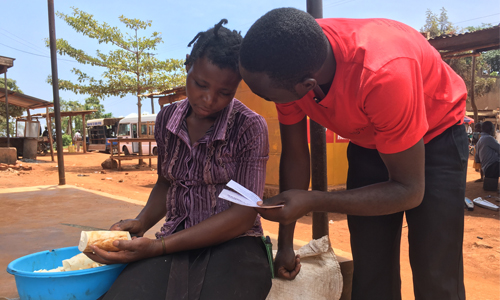Save the Mothers research assistant Chrispus Muganyizi offers information to a young woman during a “community drive” to promote toll-free lines. Chrispus reflects on his experiences below.
The health of a mother impacts the family and the entire community. Her access to proper healthcare largely determines her wellbeing and the wellbeing of her baby. Unfortunately, Uganda is one of the toughest places for mothers to live.
Some districts in Uganda are performing well in the provision of quality maternal health services, especially those with more and better-equipped, trained health workers. This has resulted in lower numbers of maternal and child deaths in those areas. When I was conducting research in Western Uganda, mothers ranked the quality of maternal health services provided by health facilities as “good.” The key contributor to the reduction of maternal deaths during childbirth was having a skilled, highly-trained midwife conducting most deliveries within health facilities.
Last week my STM colleagues and I conducted community drives within regions of Central Uganda, including Naggalama, Kawolo, and Buikwe. The drives involved the use of public address (PA) systems to increase awareness about the existence and use of toll-free lines.
Similar to 911
The toll-free line system is similar to the emergency number 911, through which mothers who have pregnancy or childbirth-related questions or emergencies, can call and speak directly with a health worker in the maternity ward. On the drives, my colleagues and I handed out flyers listing the toll-free numbers. We explained to locals how to use and work the toll-free line. To my surprise, men, young women, and mothers started expressing dissatisfaction towards the quality of maternal and other health services offered by the health facilities.
Community members expressed concerns about the inadequacy of immediate attention and care offered by health workers during childbirth. In addition, the high fees charged by both private and public health facilities were not affordable to most of the rural poor population. The people distrusted their health facilities, leading to low utilization of safe maternal health services and higher use of Traditional Birth Attendants who are affordable, accessible, and culturally acceptable.
One woman told me, she had gone with her sister, who was in labour, to a nearby health facility. “But the midwives on duty just ignored us,” she said. “They were telling us, ‘It is not yet time.’ Due to negligence of the midwives, and their lack of immediate of attention, my sister ended up delivering on the grass without the help of a skilled birth attendant.”
Health workers offer a different perspective
But midwives and health workers say that health facilities are few in the region. Poor roads make transportation difficult. By the time labouring women reach the health facility, the pregnant mother is often fatigued and not able to push. Such transit delays can also lead to serious complications so by the time they reach the health facility the health workers do not have the resources or expertise available to save their lives.
Community drives provide an opportunity to see the realities at ground level. When mothers, community members, and midwives voice their concerns about the state of maternal health services, I realize the gaps that exist in maternal health service delivery.
However, this is not a blame game. There is a need for all stakeholders to work together to address this issue. Research yields understanding of the challenges towards provision of better health care. That is why I am grateful for my role at Save the Mothers. By tracking the use and overall quality of the toll-free line system, I believe my research will help to facilitate development of policies and strategies to overcome the challenges. It will also help to increase advocacy and lobbying for resources to strengthen the health system.
The community drives were effective since they increased people’s awareness about how to use the toll-free lines, which has increased use of the service.
Although there is more progress to be made, the work Save the Mothers is doing together with the health facilities will gradually close the gaps that exist in maternal health service delivery.

